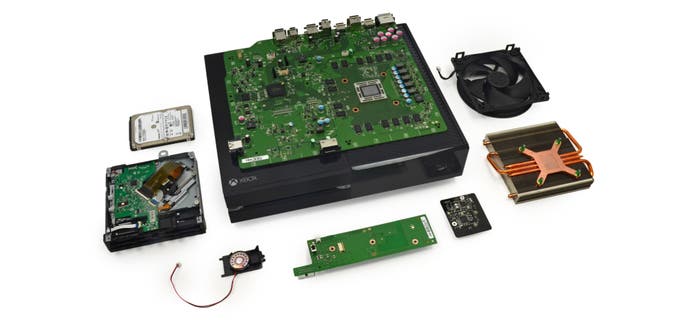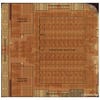Smaller, cheaper, cooler Xbox One processor in development
Completed design opens the door to a cost-reduced 'slim' console.
Chip designer AMD has developed a smaller, more cost-effective 20nm version of the main processor found in Xbox One, opening the door to a cheaper 'slim' version of the Microsoft console. The news comes from the LinkedIn bio of AMD's senior manager of SOC (system on chip) physical design, as discovered by Mosen from the Beyond3D forums. The entry in question says he "successfully planned and executed the first APU for Microsoft's Xbox One Game Console in 28nm technology and a cost-reduced derivative in 20nm technology."
Technology becomes smaller and more powerful according to the density of transistors crammed onto a piece of silicon, with production processes measured at the nanometre level. Currently, the Xbox One and PS4 processors are fabricated at 28nm, meaning each transistor measures 28 thousand-millionths of a metre. The new chip design shrinks that to 20nm. According to TSMC (Taiwan Semiconductor Manufacturing Company) - the factory that physically makes the Xbox One and PS4 processors - shrinking down the same chip provides 30 per cent higher speed or 25 per cent less power than the existing processor, at 1.9 times the density.
The main processor inside Xbox One is one of its most expensive components, with the current 28nm version estimated to cost Microsoft something in the region of $50 per chip. Physically reducing the size by 1.9x means more processors can fit onto the silicon wafers used in production, lowering costs. We can safely assume Microsoft's objectives with the revised processor will be to provide exactly the same performance as the current model (a 30 per cent performance boost offered by the smaller chip is an intriguing thought, but unlikely to materialise), while the reduced power consumption makes for a cooler, more efficient console.
This opens the door to a much smaller cooling assembly and a thinner chassis, which in turn leads to cost benefits throughout the whole manufacturing and distribution process - smaller consoles means less packaging, meaning cost savings in physically shipping the units out from China to retail markets worldwide.

Meanwhile, Microsoft is also looking at other ways to streamline the Xbox One design. The company appears to be investigating new memory technologies, advertising for an electrical engineer (thanks again, Mosen) whose responsibilities include "development of the memory subsystem" and evaluating "different solution options for performance, functionality, stability, cost and risk for the memory subsystem within the platform."
Microsoft is specifically looking for someone with familiarity of existing DDR3 and DDR4 memory technology, suggesting that this position is more about revising the current-gen Xbox as opposed to developing any successor. Top-end 2133MHz DDR3 is currently utilised in Xbox One, but a move across to DDR4 makes sense when the time is right - if only for reasons of economy - although making the switch would require considerable engineering effort. Another option is a move to lower-voltage LPDDR3 - this offers high-density memory modules, meaning fewer of them would be required, allowing for a smaller motherboard. However, this technology is considerably more expensive than Microsoft's current choice - RAM availability is plentiful, but acquiring modules that could run at 2133MHz wouldn't be easy. LPDDR3 seems like a viable mid-term option, while we suspect that any potential move onto DDR4 RAM is years away.
However, with the cost-reduced design of the main Xbox One processor complete, production economics are the only thing stopping Microsoft from creating a 20nm-powered 'Xbox One Slim' right now. Newer chip fabrication technologies are notoriously expensive in their early years as the number of usable processors gleaned from each silicon wafer (the "yield") is very low. There's also a question of capacity. Right now, it's believed that the majority of TSMC's 20nm production line is occupied creating the A8 and A8X processors used in the iPhone 6, 6 Plus and iPad Air 2. Behind Apple, AMD and Nvidia are waiting for access to 20nm technology in order to power their next-gen PC graphics cards, due in 2015.
The move from one production node to another historically takes much longer on console, as existing production technologies become more reliable (meaning a higher chip yield per wafer). However, it's clear AMD has incorporated measures into both Xbox One and PS4 processors to make the transition onto small fabrication technologies faster this time around. On the silicon itself, the graphics portion of the processor features a full 14 compute units on Xbox One and 20 on PlayStation 4. In both cases, two compute units are disabled on the final retail units in order to increase production yield.
The 28nm production process was very mature by the time the new wave of consoles went into production, meaning there was probably little need to disable any part of the chip on either console. Indeed, in our Xbox One architects interview, the team discussed with us how they could enable the full 14 compute unit graphics hardware on development systems for testing purposes. However, deactivating those parts of the chip means the technology should be able to transition across to 20nm more quickly - the production yield per wafer increases as the chips don't need to be absolutely perfect. In short, both the Xbox One and PS4 processors were designed to be cheap to produce on current 28nm production technology, but flexible enough to move across to more advanced fabrication nodes more quickly than their predecessors.
It's worth pointing out that while there's been no official acknowledgement of a 20nm version of the PS4's main processor, it's almost certain AMD will have carried out the same work for Sony as it has for Microsoft. A PS4 Slim is just as inevitable as a downscaled, cheaper Xbox One, but we should only expect to see them hit the production lines when the financials make sense. Microsoft is staying silent, declining to comment on the cost-reduced processor.





.png?width=291&height=164&fit=crop&quality=80&format=jpg&auto=webp)





